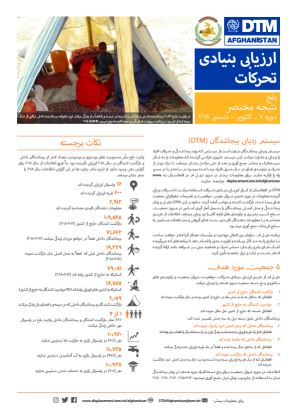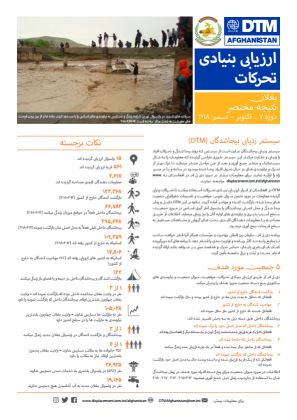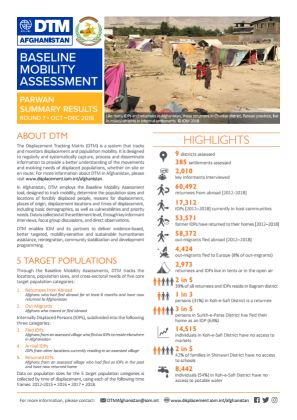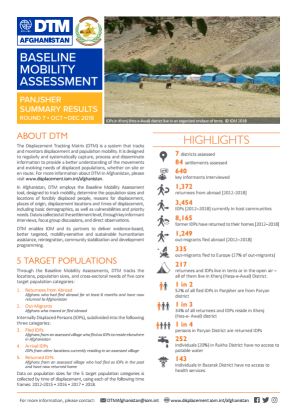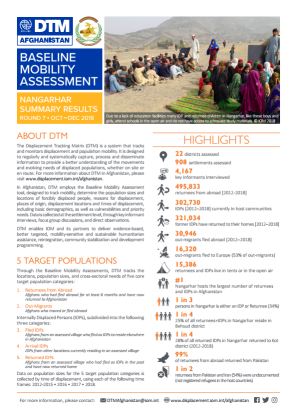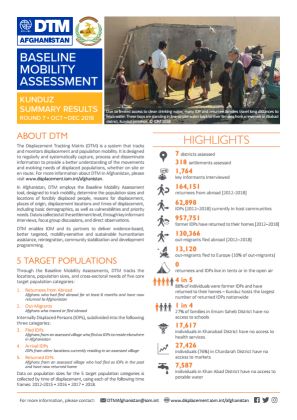-
Countries
-
Data and Analysis
-
Special Focus
-
Crisis Responses
Afghanistan
Afghanistan
Desplazados internos rastreados
Movimientos de desplazamiento
4,187,000
IDMC 2023
Ronda de recopilación de datos
Sobre Afghanistan
The Displacement Tracking Matrix (DTM) is an information management system of tools and methodologies used to track and monitor displacement and population mobility. In Afghanistan, IOM activated the DTM programme in January 2017 in response to the substantial increase of Afghans returning home from neighbouring countries, as well as record levels of internal displacement. DTM in Afghanistan is designed to regularly and systematically capture, process and disseminate multi-layered information about the population sizes, locations, geographic distribution, movements, vulnerabilities, evolving multisectoral needs, and the drivers of migration of returnees, IDPs, migrants and mobile populations. DTM implements baseline mobility assessments, flow monitoring, registrations, and various migration surveys to provide an essential evidence base that enables decision-makers and humanitarian, reintegration and development partners to maximize resources and deliver efficient, better-targeted, mobility-sensitive and sustainable humanitarian; reintegration, community stabilization and development programming.
The value-added impact of DTM in Afghanistan is to inform action and results for people in need. DTM Afghanistan implements its activities at both the national and provincial levels. DTM works closely with other (IOM) programmes through referring identified populations in need of assistance at flow monitoring points to IOM’s Cross Border Return and Reintegration, Protection, Humanitarian Assistance, and Reintegration and Development (RADA) programmes. DTM Afghanistan also supports humanitarian partners and clusters, including WFP, FAO, UNHCR, IRC, DRC, NRC, and WHO, among many others, by providing emergency tracking updates in large-scale or sudden onset movements, such as emergency event tracking and drought response. Furthermore, stabilization and development actors, including IOM’s RADA programme, and the World Bank leverage DTM’s information to select priority communities and districts with higher concentrations of IDPs and returnees to receive reintegration and livelihoods assistance and improvements to core infrastructure and essential services. In support of health partners, including WHO, UNICEF, and the Humanitarian Health Cluster, DTM data informs the selection of priority, at-risk districts, border areas, communities, and health facilities in need of strengthened capacity, response, surveillance, and risk education for polio, TB, COVID-19, and other infectious diseases.
Contacto
Modher ALHAMADANI
Senior Programme Coordinator - DTM
malhamadani@iom.int
DTM AFGHANISTAN
DTMAFGHANISTAN@iom.int
Current Donors
- Republic of Korea
- Norway
- CERF
- Canada
- Italy
- EU
- FCDO
Para obtener resultados de búsqueda más avanzados, vaya a la Página de búsqueda avanzada de informes
افغانستان — فراه :: نتایج مختصر ارزیابی بنیادی تحرکات :: اکتوبر — دسمبر ۲۰۱۸
DTM در افغانستان از ابـزار ارزیـابی بنیـادی تحـرکات اسـتفاده میکنـد تا تحـرکات ردیابی گردیده معلومات در مورد تخمین مـیزان نفوس، موقعیـت و تقسیمات جغرافیایی جمعیت های بیجا شده اجباری، بازگشت کننده و مهاجر آماده گردد.
افغانستان — دایکندی :: نتایج مختصر ارزیابی بنیادی تحرکات :: اکتوبر — دسمبر ۲۰۱۸
DTM در افغانستان از ابـزار ارزیـابی بنیـادی تحـرکات اسـتفاده میکنـد تا تحـرکات ردیابی گردیده معلومات در مورد تخمین مـیزان نفوس، موقعیـت و تقسیمات جغرافیایی جمعیت های بیجا شده اجباری، بازگشت کننده و مهاجر آماده گردد.
افغانستان — بامیان :: نتایج مختصر ارزیابی بنیادی تحرکات :: اکتوبر — دسمبر ۲۰۱۸
DTM در افغانستان از ابـزار ارزیـابی بنیـادی تحـرکات اسـتفاده میکنـد تا تحـرکات ردیابی گردیده معلومات در مورد تخمین مـیزان نفوس، موقعیـت و تقسیمات جغرافیایی جمعیت های بیجا شده اجباری، بازگشت کننده و مهاجر آماده گردد.
افغانستان — بلخ :: نتایج مختصر ارزیابی بنیادی تحرکات :: اکتوبر — دسمبر ۲۰۱۸
DTM در افغانستان از ابـزار ارزیـابی بنیـادی تحـرکات اسـتفاده میکنـد تا تحـرکات ردیابی گردیده معلومات در مورد تخمین مـیزان نفوس، موقعیـت و تقسیمات جغرافیایی جمعیت های بیجا شده اجباری، بازگشت کننده و مهاجر آماده گردد.
افغانستان — بغلان :: نتایج مختصر ارزیابی بنیادی تحرکات :: اکتوبر — دسمبر ۲۰۱۸
DTM در افغانستان از ابـزار ارزیـابی بنیـادی تحـرکات اسـتفاده میکنـد تا تحـرکات ردیابی گردیده معلومات در مورد تخمین مـیزان نفوس، موقعیـت و تقسیمات جغرافیایی جمعیت های بیجا شده اجباری، بازگشت کننده و مهاجر آماده گردد.
افغانستان — بادغیس :: نتایج مختصر ارزیابی بنیادی تحرکات :: اکتوبر — دسمبر ۲۰۱۸
DTM در افغانستان از ابـزار ارزیـابی
افغانستان — بدخشان :: نتایج مختصر ارزیابی بنیادی تحرکات :: اکتوبر — دسمبر ۲۰۱۸
DTM در افغانستان از ابـزار ارزیـابی بنیـادی تحـرکات اسـتفاده میکنـد تا تحـرکات ردیابی گردیده معلومات در مورد تخمین مـیزان نفوس، موقعیـت و تقسیمات جغرافیایی جمعیت های بیجا شده اجباری، بازگشت کننده و مهاجر آماده گردد.
Afghanistan — Zabul Baseline Mobility Assessment Summary Results (October—December 2018)
In Afghanistan, DTM employs the Baseline Mobility Assessment tool, designed to track mobility, determine the population sizes, locations and geographic distribution of forcibly displaced, return and migrant populations, reasons for displacement, places of origin, and times of displacement, as wel
Afghanistan — Wardak Baseline Mobility Assessment Summary Results (October—December 2018)
In Afghanistan, DTM employs the Baseline Mobility Assessment tool, designed to track mobility, determine the population sizes, locations and geographic distribution of forcibly displaced, return and migrant populations, reasons for displacement, places of origin, and times of displacement, as wel
Afghanistan — Uruzgan Baseline Mobility Assessment Summary Results (October—December 2018)
In Afghanistan, DTM employs the Baseline Mobility Assessment tool, designed to track mobility, determine the population sizes, locations and geographic distribution of forcibly displaced, return and migrant populations, reasons for displacement, places of origin, and times of displacement, as wel
Afghanistan — Takhar Baseline Mobility Assessment Summary Results (October—December 2018)
In Afghanistan, DTM employs the Baseline Mobility Assessment tool, designed to track mobility, determine the population sizes, locations and geographic distribution of forcibly displaced, return and migrant populations, reasons for displacement, places of origin, and times of displacement, as wel
Afghanistan — Sar-e-Pul Baseline Mobility Assessment Summary Results (October—December 2018)
In Afghanistan, DTM employs the Baseline Mobility Assessment tool, designed to track mobility, determine the population sizes, locations and geographic distribution of forcibly displaced, return and migrant populations, reasons for displacement, places of origin, and times of displacement, as wel
Afghanistan — Samangan Baseline Mobility Assessment Summary Results (October—December 2018)
In Afghanistan, DTM employs the Baseline Mobility Assessment tool, designed to track mobility, determine the population sizes, locations and geographic distribution of forcibly displaced, return and migrant populations, reasons for displacement, places of origin, and times of displacement, as wel
Afghanistan — Parwan Baseline Mobility Assessment Summary Results (October—December 2018)
In Afghanistan, DTM employs the Baseline Mobility Assessment tool, designed to track mobility, determine the population sizes, locations and geographic distribution of forcibly displaced, return and migrant populations, reasons for displacement, places of origin, and times of displacement, as wel
Afghanistan — Panjsher Baseline Mobility Assessment Summary Results (October—December 2018)
In Afghanistan, DTM employs the Baseline Mobility Assessment tool, designed to track mobility, determine the population sizes, locations and geographic distribution of forcibly displaced, return and migrant populations, reasons for displacement, places of origin, and times of displacement, as wel
Afghanistan — Paktya Baseline Mobility Assessment Summary Results (October—December 2018)
In Afghanistan, DTM employs the Baseline Mobility Assessment tool, designed to track mobility, determine the population sizes, locations and geographic distribution of forcibly displaced, return and migrant populations, reasons for displacement, places of origin, and times of displacement, as wel
Afghanistan — Paktika Baseline Mobility Assessment Summary Results (October—December 2018)
In Afghanistan, DTM employs the Baseline Mobility Assessment tool, designed to track mobility, determine the population sizes, locations and geographic distribution of forcibly displaced, return and migrant populations, reasons for displacement, places of origin, and times of displacement, as wel
Afghanistan — Nuristan Baseline Mobility Assessment Summary Results (October—December 2018)
In Afghanistan, DTM employs the Baseline Mobility Assessment tool, designed to track mobility, determine the population sizes, locations and geographic distribution of forcibly displaced, return and migrant populations, reasons for displacement, places of origin, and times of displacement, as wel
Afghanistan — Nimroz Baseline Mobility Assessment Summary Results (October—December 2018)
In Afghanistan, DTM employs the Baseline Mobility Assessment tool, designed to track mobility, determine the population sizes, locations and geographic distribution of forcibly displaced, return and migrant populations, reasons for displacement, places of origin, and times of displacement, as wel
Afghanistan — Nangarhar Baseline Mobility Assessment Summary Results (October—December 2018)
In Afghanistan, DTM employs the Baseline Mobility Assessment tool, designed to track mobility, determine the population sizes, locations and geographic distribution of forcibly displaced, return and migrant populations, reasons for displacement, places of origin, and times of displacement, as wel
Afghanistan — Logar Baseline Mobility Assessment Summary Results (October—December 2018)
In Afghanistan, DTM employs the Baseline Mobility Assessment tool, designed to track mobility, determine the population sizes, locations and geographic distribution of forcibly displaced, return and migrant populations, reasons for displacement, places of origin, and times of displacement, as wel
Afghanistan — Laghman Baseline Mobility Assessment Summary Results (October—December 2018)
In Afghanistan, DTM employs the Baseline Mobility Assessment tool, designed to track mobility, determine the population sizes, locations and geographic distribution of forcibly displaced, return and migrant populations, reasons for displacement, places of origin, and times of displacement, as wel
Afghanistan — Kunduz Baseline Mobility Assessment Summary Results (October—December 2018)
In Afghanistan, DTM employs the Baseline Mobility Assessment tool, designed to track mobility, determine the population sizes, locations and geographic distribution of forcibly displaced, return and migrant populations, reasons for displacement, places of origin, and times of displacement, as wel
Afghanistan — Kunar Baseline Mobility Assessment Summary Results (October—December 2018)
In Afghanistan, DTM employs the Baseline Mobility Assessment tool, designed to track mobility, determine the population sizes, locations and geographic distribution of forcibly displaced, return and migrant populations, reasons for displacement, places of origin, and times of displacement, as wel
Pagination
Para obtener resultados de búsqueda más avanzados, vaya a la Página de búsqueda avanzada de conjuntos de datos
Pagination
Pagination
- First page
- Previous page
- 1
- 2
- 3
- 4
- 5





